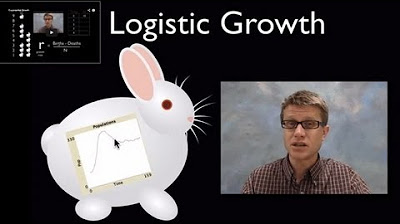Population Dynamics: Carrying Capacity and Limiting Factors
Summary
TLDRThis video explains the concept of exponential growth in populations, where organisms reproduce and increase in number over time. However, this growth is limited by factors like severe weather, predators, disease, competition for resources, and human impact, leading to a phenomenon known as carrying capacity—the maximum number of individuals an environment can support. The video emphasizes that if populations exceed this limit, resources become scarce, leading to competition and survival of the fittest. Using the analogy of a sponge, the video illustrates how a habitat can only support a finite number of individuals before its resources are exhausted.
Takeaways
- 😀 As individuals in a population grow older and stay healthy, they reproduce, leading to population increase.
- 😀 This type of growth is called exponential growth, where the population grows larger over time.
- 😀 Exponential growth would continue indefinitely if there were no limiting factors.
- 😀 Limiting factors prevent unchecked population growth by causing individuals to die off.
- 😀 Common limiting factors include severe weather, predators, disease, parasites, and competition for resources.
- 😀 Human threats such as habitat destruction, overhunting, and vehicle accidents also act as limiting factors.
- 😀 Carrying capacity refers to the maximum number of individuals that a habitat can support based on available resources.
- 😀 A habitat has finite resources (food, water, shelter), and once these are used up, the population cannot continue to grow.
- 😀 If the population exceeds the carrying capacity, individuals will have to compete for limited resources.
- 😀 Only the strongest and most fit individuals are likely to survive when competition for resources becomes intense.
Q & A
What is exponential growth in population dynamics?
-Exponential growth occurs when a population increases at a constant rate over time, with each individual reproducing and having offspring as long as they are healthy.
Why doesn't exponential growth occur in the wild?
-In the wild, limiting factors such as severe weather, predators, disease, and resource competition prevent continuous exponential growth, leading to a more balanced population.
What are some examples of limiting factors in a population?
-Limiting factors include severe weather, predators, disease, parasites, competition for resources, and human threats like habitat destruction, overhunting, and vehicle accidents.
What is carrying capacity?
-Carrying capacity is the maximum number of individuals a habitat can support, based on the availability of resources like food, water, and shelter.
How is carrying capacity illustrated in the graph?
-In the graph, carrying capacity is represented by the blue line, while the population is shown by the red line. The blue line indicates the maximum sustainable population size.
What happens if the population exceeds the carrying capacity?
-If the population exceeds the carrying capacity, resources become scarce, leading to competition and potentially causing the population to decrease as weaker individuals struggle to survive.
How does the concept of a sponge relate to carrying capacity?
-The sponge analogy suggests that just like a sponge can only soak up a limited amount of water, a habitat can only support a certain number of individuals due to limited resources.
What role do competition and fitness play in population survival?
-When the population exceeds the carrying capacity, individuals must compete for limited resources. Only the strongest and most fit individuals are likely to survive and reproduce.
What might cause a population to decrease despite initial growth?
-A population can decrease if limiting factors like disease, predation, or resource scarcity cause a high mortality rate, balancing out the growth over time.
How can human actions influence the carrying capacity of a population?
-Human activities such as habitat destruction, overhunting, and pollution can reduce the carrying capacity of a habitat, making it harder for populations to thrive.
Outlines

هذا القسم متوفر فقط للمشتركين. يرجى الترقية للوصول إلى هذه الميزة.
قم بالترقية الآنMindmap

هذا القسم متوفر فقط للمشتركين. يرجى الترقية للوصول إلى هذه الميزة.
قم بالترقية الآنKeywords

هذا القسم متوفر فقط للمشتركين. يرجى الترقية للوصول إلى هذه الميزة.
قم بالترقية الآنHighlights

هذا القسم متوفر فقط للمشتركين. يرجى الترقية للوصول إلى هذه الميزة.
قم بالترقية الآنTranscripts

هذا القسم متوفر فقط للمشتركين. يرجى الترقية للوصول إلى هذه الميزة.
قم بالترقية الآنتصفح المزيد من مقاطع الفيديو ذات الصلة
5.0 / 5 (0 votes)






